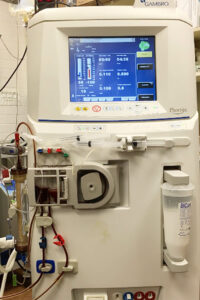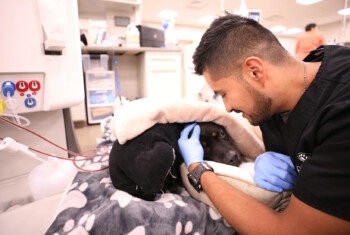Get the facts on dialysis for pets.
In recent years, the number of academic and private practices offering dialysis has grown exponentially. The most concentrated region of dialysis centers in the United States is the Northeast. In Manhattan alone, there are now two hospitals that offer dialysis.
While peritoneal dialysis can be performed without specialized equipment, the procedure requires intensive management, is often accompanied by multiple complications that may hinder the delivery of therapy, and is less efficient than hemodialysis. Furthermore, the expense of peritoneal dialysis can equal or exceed that of hemodialysis. Therefore, the author prefers to utilize hemodialysis when it is available.
Currently, in veterinary medicine acute kidney injury is the primary indication for hemodialysis.
One of the hallmarks of acute kidney injury is the potential for at least partial recovery of renal function. Therefore, hemodialysis is employed as a means of achieving metabolic stability so that the patient may survive long enough for the kidneys to regain adequate function.
When hemodialysis is initiated early in the course of disease (prior to the development of hyperkalemia, fluid overload, and severe acidemia) outcomes (i.e. survival and renal recovery) are far superior to when hemodialysis is utilized as a salvage procedure, long after conventional therapy has failed. Indications for hemodialysis in cases of acute kidney injury are listed below:
Azotemia.
There are no specific thresholds for blood urea and creatinine concentrations that warrant  hemodialysis. If the patient has clinical signs attributed to uremia, and there are no comorbid conditions that can be addressed to improve the patient’s condition, hemodialysis should be considered. Occasionally, patients have an underlying disease that precipitates acute kidney injury. In these cases in which acute kidney injury is a manifestation of systemic disease (e.g., systemic inflammatory response syndrome), it may be the only problem amenable to treatment.
hemodialysis. If the patient has clinical signs attributed to uremia, and there are no comorbid conditions that can be addressed to improve the patient’s condition, hemodialysis should be considered. Occasionally, patients have an underlying disease that precipitates acute kidney injury. In these cases in which acute kidney injury is a manifestation of systemic disease (e.g., systemic inflammatory response syndrome), it may be the only problem amenable to treatment.
Oliguria and anuria.
When a patient’s urine production begins to decline, fluid overload is imminent. Rarely if ever, in cases of intrinsic acute kidney injury can aggressive fluid therapy restore glomerular filtration so that urine production resumes.
The only situation in which aggressive fluid therapy is warranted to improve glomerular filtration is when a volume deficit (absolute or relative) is present. In cases of normovolemic oliguria or anuria, continued administration of intravenous fluids, along with enteral and parenteral medications/nutrition, almost inevitably leads to fluid overload.
In both human and veterinary medicine, fluid overload has been strongly associated with increased mortality. Consideration of hemodialysis at the time that decreased urine production is recognized allows for the prevention of this serious complication. Prevention of fluid overload can easily be accomplished with regular hemodialysis treatments and is far easier to accomplish than a reversal of established fluid overload.
Hyperkalemia.
The major route of potassium excretion is via the kidneys and, in cases of acute decline in glomerular filtration, potassium accumulates rapidly, reaching life-threatening extracellular concentrations within hours. Several treatments for decreasing blood concentrations of potassium by affecting transcellular shifts (e.g., insulin, β-agonists, sodium bicarbonate) or restoring an appropriate resting/threshold membrane gradient (e.g., intravenous calcium salts) have been advocated, but these treatments do not reduce the whole body potassium burden. Furthermore, their effects are modest and transient, and typically the magnitude of response declines with each successive use.
Hemodialysis is the only treatment that effectively removes potassium from the body and can reduce blood potassium concentrations into a range compatible with survival within minutes. The effects of hemodialysis are far more sustained (lasting up to 48 hours) than the aforementioned treatments, and can be repeated indefinitely without loss of effectiveness.
Survival rate.
The rate of survival to hospital discharge for hemodialysis patients with acute kidney injury and absence of detectable, underlying  chronic kidney disease is approximately 50%. Of those discharged from the hospital alive, the one-year survival rates are 76% and 63% for cats and dogs, respectively.7
chronic kidney disease is approximately 50%. Of those discharged from the hospital alive, the one-year survival rates are 76% and 63% for cats and dogs, respectively.7
While these numbers are similar to those reported in human medicine, it is highly likely that survival rates will improve in the future, as referral for hemodialysis occurs earlier in the course of disease.
Hemodialysis can be successfully utilized for the treatment of chronic kidney disease, as well. The treatment goals, however, are drastically different compared with those for acute kidney injury. For patients with end-stage chronic kidney disease, hemodialysis may be thought of as analogous to palliative chemotherapy or radiation therapy for patients with oncologic diseases.
The goals of treatment are to maintain an acceptable quality of life, rather than the metrics of tumor response in the case of cancer treatment or precise regulation of uremic, acid base, electrolyte, and fluid balance in the case of chronic hemodialysis.
 Side effects that negatively affect the quality of life are considered unacceptable. Patients that receive the greatest benefit from chronic hemodialysis are typically those with stage IV (International Renal Interest Society) chronic kidney disease that are free of comorbidities (e.g. significant cardiovascular, gastrointestinal, neurologic, or orthopedic disease). Unfortunately, specific prognostic factors for successful treatment of chronic kidney disease with hemodialysis have not been identified to date.
Side effects that negatively affect the quality of life are considered unacceptable. Patients that receive the greatest benefit from chronic hemodialysis are typically those with stage IV (International Renal Interest Society) chronic kidney disease that are free of comorbidities (e.g. significant cardiovascular, gastrointestinal, neurologic, or orthopedic disease). Unfortunately, specific prognostic factors for successful treatment of chronic kidney disease with hemodialysis have not been identified to date.
Renal transplantation is preferred over chronic hemodialysis for cats, but the availability and success of transplantation is extremely limited in dogs. Therefore, the majority of chronic hemodialysis cases are dogs.
There are several logistical considerations regarding patient selection for hemodialysis. These considerations include client resources (time, financial, emotional), patient size and temperament, and chronicity of disease. However, as the field of veterinary medicine is ever-evolving, the implications of these considerations continue to change. Therefore, it is important that consultation with a veterinary hemodialysis facility is sought as soon as a potential candidate is identified, so that all parties involved can collaborate to provide optimal care for the patient.


